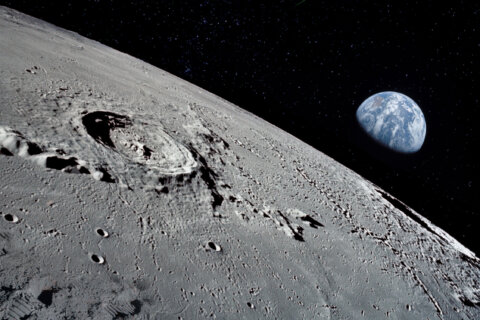Jason Fraley, WTOP film critic
WASHINGTON – They say art imitates life. But no matter how hard Hollywood development execs try, they can’t plan for a breaking news event happening a month before their film is released. Thus the zeitgeist has grabbed “Argo,” chillingly coinciding with last month’s tragic attack on the U.S. consulate in Benghazi, Libya, which killed Ambassador Chris Stevens and three other Americans.
Viewers will be unable to shake those memories as they watch the movie’s opening scene, which uses archival footage to recreate the storming of the U.S. Embassy in Iran in 1979, when 52 Americans were held for 444 days.
What follows is a story that’s too good to be true, except that it absolutely is, based on the book “Master of Disguise” by former CIA agent and current Maryland resident Tony Mendez and the ensuing Wired Magazine article by Joshuah Bearman.
It tells Mendez’s true story of freeing six American diplomats, who escaped out the backdoor of the U.S. embassy and hid in the Canadian embassy in Tehran. His idea? Pretend he’s from Hollywood visiting Iran to scout desert locations for a new sci-fi blockbuster called “Argo.” The diplomats will pretend they’re part of his film crew, and leave with him on a plane back to the United States.
This stranger-than-fiction tale was not declassified until 1997, so you can imagine the appeal for screenwriter Chris Terrio and producers Ben Affleck, George Clooney (“Syriana”) and Grant Heslov (“Good Night and Good Luck”), who used Istanbul as a stand-in for Tehran.
The film provides a rare blend of nail-biting suspense and first-rate comedy. The R-rated laughs are laced with profanity, especially their running joke, “Argo f*ck yourself.”
Hats off to Alan Arkin (“Little Miss Sunshine”), who plays the film’s fake producer (“If we’re gonna make a fake movie, it’s gonna be a fake hit”), and John Goodman (“The Big Lebowski”), who plays legendary special effects wizard John Chambers (“So you want to come to Hollywood an act like a big shot without actually doing anything? You’ll fit right in”). Chambers was recruited after winning an honorary Oscar for his work in “Planet of the Apes” (1968). If you check his filmography, you’ll notice a three-year gap between 1977-1980, when he was coordinating with the CIA on the “Argo” project.
Meanwhile, the suspense is driven by Bryan Cranston (“Breaking Bad”) as Mendez’s CIA boss, Victor Garber (“Titanic”) as the Canadian Ambassador risking his life to provide the Americans sanctuary, and the supporting cast of six diplomats, whose in-fighting rivals the jury in “12 Angry Men.”
As for the lead role, Affleck casting himself as Mendez reminds me of the bizarre casting of Charlton Heston as the Latino lead in Orson Welles’ noir classic “Touch of Evil” (1958). Be that as it may, Affleck effectively carries the film as the workaholic spy estranged from his wife and son. I’m beginning to think he’s more talented as a storyteller than as an actor, from co-writing “Good Will Hunting” (1997) to directing “Gone Baby Gone” (2007) and “The Town” (2010). Affleck may soon pull a Redford and shift almost exclusively behind the camera, as “Argo” figures to earn him a directing nomination.
His pacing here is masterful, using parallel action to cut between (a) diplomats boarding an airplane in Tehran, (b) Iran’s skeptical security staff reviewing their documents, (c) a ringing phone in Los Angeles as Arkin and Goodman wait for a film set to finish shooting. I haven’t felt this much tension over exit visas since “Casablanca” (1942).
The editing by Oscar-nominated editor William Goldberg (“Heat”) is precise, using clever transitions, like a spinning ball to a spinning Led Zeppelin record, which highlights a classic rock soundtrack of Van Halen and Dire Straits to complement the tense score by Oscar-nominated composer Alexandre Desplat (“The King’s Speech,” “The Curious Case of Benjamin Button”).
Affleck also pulls symbolism from Oscar-nominated cinematographer Rodrigo Prieto (“Brokeback Mountain,” “Amores Perros”) to subconsciously show how Mendez is the calm amidst the storm. During the diplomats’ “location scouting” trip, the fake film crew’s van is swarmed by protesters banging on the windows. Prieto shoots the uneasy diplomats with a shaky, handheld camera, while shooting Affleck with a static camera, likely achieved with a waiter tray device in the passenger window.
Most impressively, Affleck knows how to visually express his themes through the juxtaposition of images. One second, he shows Iranian citizens devouring Kentucky Fried Chicken. The next, he shows a man hanged to death from a construction crane. In just two shots, he reminds us of the Shah’s pre-revolution westernization of Iran, then drives home the hard-line oppression of Ayatollah Khomeini, whose portrait features prominently in the background throughout the film.
If there is one minor flaw, it comes during an “all is lost” montage of Affleck drinking away his demons in a hotel room. The scene feels slightly rushed, a little cliche, and pales in comparison to Martin Sheen’s alcoholic hotel meltdown in “Apocalypse Now” (1979), which Hollywood produced the same year as the “Argo” mission.
Indeed, the specter of 70s Hollywood drips from every frame, opening with the old school Warner Bros logo from the ’70s and ending with a tracking shot across “Star Wars” action figures. Affleck includes a dialogue reference to “Network” (1976), teletype shots reminiscent of “All the President’s Men” (1976), magazine ads for “Kramer vs. Kramer” (1979) and Arkin bouncing a ball like Steve McQueen in “The Great Escape” (1963). It’s fitting that Mendez’s epiphany should come while remotely watching a TV movie with his son. It’s a reminder that movies are not merely an escape for mankind; they are the epitome of our childlike creativity.
Whether “Argo” will be mentioned in the same breath as those aforementioned classics remains to be seen, but in the initial adrenaline rush, it sure feels possible.
“Depicting somebody going into Tehran at that time with all these hostages being held and the clock is ticking, that was an incredibly tense time,” said CIA veteran Peter Earnest, head of the International Spy Museum in Washington, which showed “Argo” to its members Thursday night.
“It was also an incredibly tense time in Washington, and some movies do a better job than others in capturing the tension of the negotiations between the White House, the CIA and the State Department,” Earnest said. “Many of the films take off on the theme that there’s something rotten in the agency, some guy has deceived everybody … that there’s some sort of cabal.”
“Argo” is the opposite of such “conspiracy” films. Its CIA is heroic, not mischievous, but the heroism derives from gutsy, creative individuals who rally against skeptical superiors. It’s nice to have a “feel good” CIA thriller for a change. While conspiracy angles can be brilliant, like Matt Damon’s “The Bourne Trilogy” (2002-2007), they’ve been done so many times that many are predictable.
Case in point, last weekend I caught Denzel Washington’s “Safe House” (2012) on Redbox, and the experience was night and day compared to “Argo.” While “Safe House” bounced from action sequence to action sequence, “Argo” actually backed its thrills with compelling characters and a fascinating storyline. Who knew this film about a fake movie could make other spy thrillers seem so fake?
It’s no surprise that “Argo” killed at the Toronto Film Festival and has picked up some Best Picture buzz. The trailer plays Aerosmith’s “Dream On” for a reason. Amidst the cynicism surrounding the Libyan bloodshed and Iranian nuclear threats, audiences are craving a human success story, where for a brief moment in 1979, the height of Washington intelligence met the height of Hollywood imagination to perform an impossible, patriotic act.
Dream On, Hollywood
★ ★ ★ ★
The above rating is based on a 4-star scale. Read more from WTOP Film Critic Jason Fraley by clicking “Fraley on Film” under the “Living” tab above, following @JasonFraleyWTOP on Twitter, and checking out his blog, The Film Spectrum.








